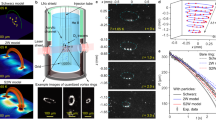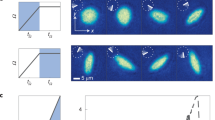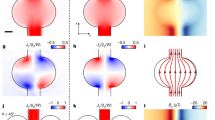Abstract
When liquid helium is cooled to below its phase transition at 2.172 K, vortices appear with cores that are only ångströms in diameter, about which the fluid circulates with quantized angular momentum1. Here we generate small particles of solid hydrogen that can be used to image the cores of quantized vortices in their three-dimensional environment of liquid helium. This technique enables the geometry and interactions of these vortices to be observed directly.
Similar content being viewed by others
Main
Since the discovery of quantized vortices2, attempts have been made to visualize them. Although the ends of parallel vortices in an array could be located3, there has been no successful imaging of vortices in arbitrary three-dimensional configurations. Suspended particles can trace fluid motions, and the velocities of frozen particles in superfluid helium have been measured since hydrogen was first condensed for the purpose4. These particles usually have diameters larger than 10 μm5,6, although smaller polymer particles have been used7.
Our technique generates smaller hydrogen particles by injecting a premixed gaseous solution of hydrogen, greatly diluted with helium, into liquid helium in its normal phase above the transition temperature (for details of methods, see supplementary information). This procedure yields a mist of randomly distributed hydrogen particles (Fig. 1a) that are smaller than the 2.7-μm resolution of our long-range microscope. The suspension so prepared is then cooled to below the transition temperature.
a–d, Images of particles (light against dark background) obtained with a camera and 105-mm lens under different conditions: a, just above the transition temperature, when they are uniformly dispersed; b, c, on branching filaments at tens of millikelvin below the transition temperature; and d, regrouping along vertical lines for steady rotation about the vertical axis. In b and c, the particles on lines are evenly separated in small regions. Scale bar, 1 mm.
Images taken with a digital camera focused on a thin laser-illuminated sheet show that not only do the particles trace fluid motions, but a fraction of them also collect on slender filaments, which are often several millimetres long (Fig. 1b, c).
Particles respond in a complicated way to superfluid flows8 and can be trapped in vortex cores9. The following evidence suggests that the observed filaments are particles collected on such cores. First, these filaments appear only below the transition temperature. Second, when the liquid-helium cell is set in steady rotation, the particles arrange themselves along uniformly spaced lines (Fig. 1d). The lines are parallel to the axis of rotation, which is in the image plane. This observation agrees with the expectation that quantized vortices form a rectilinear array aligned with the axis1. Third, if we assume that our sheet illuminates a slice of such an array, we find that the number density of lines per unit area normal to the axis of rotation, for a series of rotation rates, is consistent with Feynman's rule10, which predicts about 2,000σ lines per cm2, where V is the angular velocity of the container in radians per second.
The filaments are complex: for example, they may give rise to branched networks and to particles evenly spaced along lines. Others have speculated how particles could act as passive tracers of the flow7,8; our images indicate that the presence of particles in the superfluid may transform the topology of vortex tangles by stabilizing forks in the vortices. This technique offers a tantalizing glimpse of new phenomena for future investigation.
References
Donnelly, R. J. Quantized Vortices in Helium II (Cambridge Univ. Press, Cambridge, 1991).
Onsager, L. Proc. Int. Conf. Theor. Phys. 877–880 (Science Council of Japan, Tokyo, 1953).
Yarmchuk, E. J., Gordon, M. J. V. & Packard, R. E. Phys. Rev. Lett. 43, 214–218 (1979).
Chopra, K. L. & Brown, J. B. Phys. Rev. 108, 157 (1957).
Chung, D. Y. & Critchlow, P. R. Phys. Rev. Lett. 14, 892–894 (1965).
Murakami, M. & Ichikawa, N. Cryogenics 29, 438–443 (1989).
Zhang, T. & Van Sciver, S. W. Nature Phys. 1, 36–38 (2005).
Poole, D. R., Barenghi, C. F., Sergeev, Y. A. & Vinen, W. F. Phys. Rev. B 71, 064514-1-16 (2005).
Parks, P. E. & Donnelly, R. J. Phys. Rev. Lett. 16, 45–48 (1966).
Feynman, R. P. in Prog. Low Temp. Phys. I (ed. Gorter, C. J.) 17–53 (North Holland, Amsterdam, 1955).
Author information
Authors and Affiliations
Supplementary information
Rights and permissions
About this article
Cite this article
Bewley, G., Lathrop, D. & Sreenivasan, K. Visualization of quantized vortices. Nature 441, 588 (2006). https://doi.org/10.1038/441588a
Published:
Issue Date:
DOI: https://doi.org/10.1038/441588a
This article is cited by
-
Imaging quantized vortex rings in superfluid helium to evaluate quantum dissipation
Nature Communications (2023)
-
Interacting spiral wave patterns underlie complex brain dynamics and are related to cognitive processing
Nature Human Behaviour (2023)
-
Vibrating Microwire Resonators Used as Local Probes of Quantum Turbulence in Superfluid \(^{4}\)He
Journal of Low Temperature Physics (2023)
-
Studies on Quantum Turbulence with Vinen
Journal of Low Temperature Physics (2023)
-
Lagging heat models in thermodynamics and bioheat transfer: a critical review
Continuum Mechanics and Thermodynamics (2022)
Comments
By submitting a comment you agree to abide by our Terms and Community Guidelines. If you find something abusive or that does not comply with our terms or guidelines please flag it as inappropriate.




